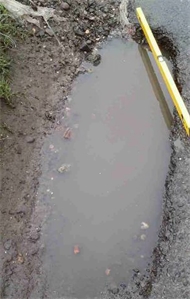Road surface defects
Carriageways (road surface)
This page provides information the different types of road surface defects that can arise every day on carriageways across the Staffordshire public highway network.
Within the Highways Infrastructure Asset Management Policy (HIAMP), 'carriagewa'y refers to a surfaced right of way intended for use by vehicles and maintained at the public expense.
We are responsible for over 6,200km of carriageways in Staffordshire including lay-bys and bus lanes.
Details of defects which are commonly reported, or which are identified during routine and reactive safety inspections can be found below.
There are numerous types of defects that can form on our roads including deep potholes, shallow potholes, surface deterioration, edge failure, cracking, rutting and subsidence.
Investment versus pothole repairs
Most of our roads were built in the second half of the twentieth century and since that time traffic volumes and the use of public highways has grown but the investment into local infrastructure has always fallen short of what is realistically required.
The maintenance of carriageways inevitably involves the ad hoc repair of road surface defects such as potholes which are a symptom of a damaged or worn out road/footway. However, when the surface has reached its end of life a structural maintenance scheme is necessary which involves the removal and replacement of the road surface and its foundations.
The continuous ‘patching’ of localised defects through pothole repairs is not sustainable and therefore can be a wasteful use of investment.
It is much better value for money to invest in preventative maintenance treatments which preserve the life of roads already in a reasonable condition and structural maintenance schemes which involve the renewal of a carriageway.
Details of how we identify and prioritise larger-scale surfacing treatments such as structural maintenance schemes can be found on the asset investment page.
Funding
For 2018-19 an investment of over £38million to maintain and improve Staffordshire’s roads has been approved. The funding includes an additional £5million specifically to repair road defects following a decision by the county council’s cabinet earlier in the year.
Over £30million will pay for the ongoing maintenance and repair of the county’s roads, with the remainder funding a range of improvement and safety schemes across Staffordshire.
Pothole action fund
In the 2016 spring budget, the Chancellor announced a ‘Pothole Action Fund’ which would be allocated to local highway authorities by the Department for Transport.
- In 2016/17 £1,069,000 was allocated to us to tackle potholes on our roads.
- In 2017/18 £1,582,000 was allocated to us to tackle potholes on our roads.
Road surface defects
There are numerous types of defects that can form on our roads including deep potholes, shallow potholes, surface deterioration, edge failure, cracking, crazing, rutting, and subsidence.
Potholes
A pothole could be described as a sharp-edged hole within the upper layers of a road surface; these are a symptom of where water has penetrated cracks in the road surface and, over time, weakened its foundation until a pothole eventually forms.
Deep potholes
Here are some examples of deep potholes found on the roads of Staffordshire.
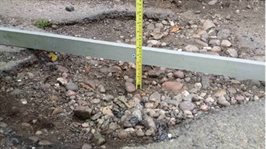
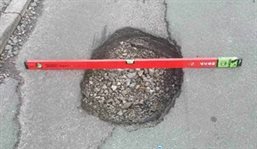
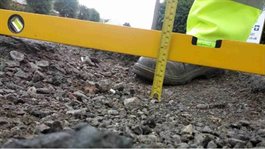
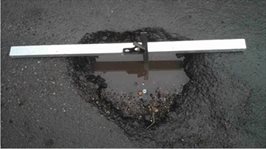
Other potholes
Not all potholes that form on our roads require immediate repair and most reported to us generally receive a lower category of priority for repair depending on their depth, position in the road and the volume of traffic using the route.
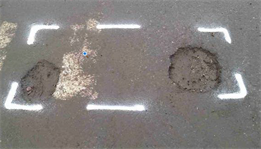
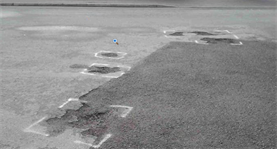
Cracking
This is a type of defect that could indicate the partial or total failure of the layers of the road surface.
Whilst not often requiring an immediate response, if left untreated there is an increased risk of water ingress which will inevitably lead to the formation of potholes.
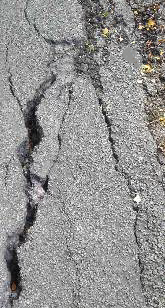
Crazing
Carriageway crazing is similar to cracking in that it is usually a symptom of partial or total failure of the layers of the road surface, but crazing usually appears as a series of adjacent polygonal cracks.
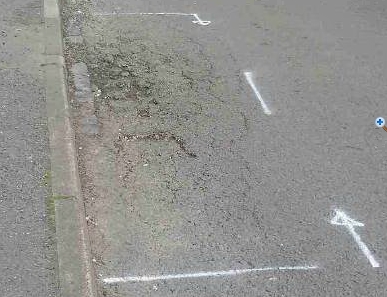
Edge failure
Edge failure is more commonly found on roads with an un-kerbed edge, such as on rural routes.
The weakest part of an un-kerbed road is that which is immediately adjacent to the verge. This part of the carriageway is called the haunch.
Running along the edge of the verge will severely damage the haunch and result in defects such as edge failure.
These are typically found near passing places on country lanes, where there is no supporting structure under the road surface.
